Discover the fascinating world of fish exhibiting an extraordinary reproductive strategy known as protogyny.
In this comprehensive and informative article, we will delve into the realm of 15 Types of Fish That are Protogynous (undergo a remarkable transformation from female to male during their lifetimes)
From the vibrant and social Clownfish to the majestic Humphead Wrasse, these fish provide captivating examples of nature’s ingenuity.
Understanding protogyny sheds light on the intricacies of aquatic life and showcases the diversity of strategies employed by different species to thrive in their environments.
Join us as we explore the biological marvel of protogyny in these underwater wonders and gain insights into the intricate balance that shapes their existence.
What is Protogyny?
Before we delve into the specific fish species, it’s essential to understand what protogyny is.
Protogyny is a type of sequential hermaphroditism in which a fish starts its life as a female, with functional ovaries producing eggs. As the fish matures, it undergoes a biological transformation, transitioning from female to male.
During this transformation, the ovaries are replaced by testes, enabling the fish to produce sperm and fertilize eggs. This phenomenon occurs in response to various environmental and social factors.
15 Types of Fish That are Protogynous
1. Clownfish (Amphiprioninae)
Clownfish are intriguing protogynous fish, known for their vibrant colors and symbiotic association with sea anemones. They can be found in coral reefs and have a distinct social structure.
The largest female in a group changes to become the dominant male after the death of the dominant male, taking on the duties of guarding the territory and caring for the eggs.
This remarkable adaptation guarantees the group’s continued reproductive success and exemplifies the complex dynamics of marine ecosystems.

| Characteristics | Details |
| Scientific Name | Amphiprioninae |
| Habitat | Coral Reefs |
| Behavior | Protogynous, Social |
| Unique Features | Symbiotic with Anemones |
2. Wrasses (Labridae)
The varied group of saltwater fish known as wrasses includes protogynous species. The California sheepshead (Semicossyphus pulcher), which transforms from a female to a male as it ages, is notable among them.
Wrasses are crucial to maintaining the ecological balance and controlling algae in reef habitats. Due to their protogynous behavior, which enables an adaptive response to changes in social and environmental situations, coral reefs and other marine environments benefit from their ability to adjust to changing conditions.
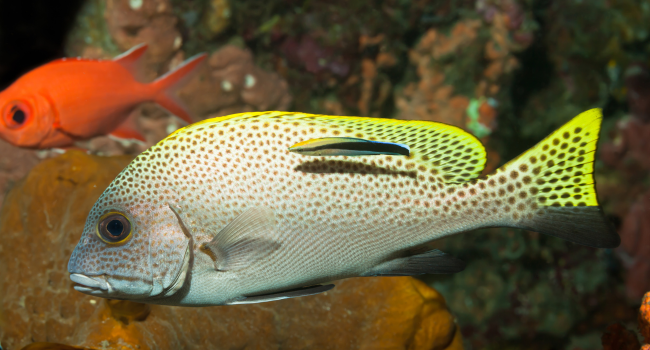
| Characteristics | Details |
| Scientific Name | Labridae |
| Habitat | Marine Environments |
| Behavior | Protogynous, Algae Control |
| Unique Features | Diversity in Coloration |
3. Grouper (Epinephelidae)
Protogynous species like the red grouper (Epinephelus morio) are part of the huge, colorful grouper family.
The larger female fish undergo a sex change as they get older, turning into males and taking part in reproduction. The ecological relevance of groupers comes from their positions as top predators in different maritime habitats.
The health and balance of marine food chains are aided by their protogynous behavior, which guarantees a stable and sustainable population structure.
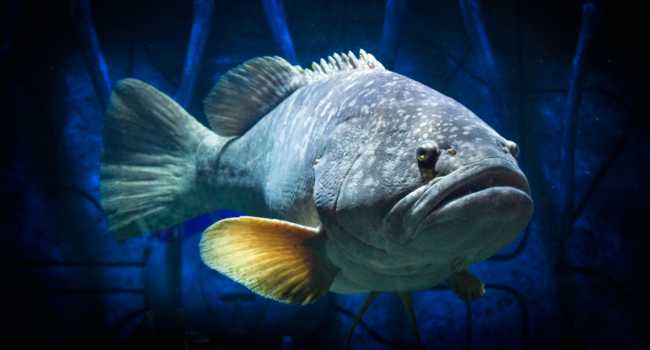
| Characteristics | Details |
| Scientific Name | Epinephelidae |
| Habitat | Warm Seas |
| Behavior | Protogynous, Apex Predator |
| Unique Features | Large Size, Vibrant Colors |
4. Parrotfish (Scaridae)
Parrotfish, with their eye-catching hues and beak-like lips, are essential for the health of coral reefs. Many parrotfish species practice protogyny, where females change into males in the absence of the dominant male.
This adaptability enables the preservation of social harmony and guarantees successful reproduction within the group. They also graze on coral that has been coated with algae, which supports the ecosystem’s resilience and coral growth.

| Characteristics | Details |
| Scientific Name | Scaridae |
| Habitat | Coral Reefs |
| Behavior | Protogynous, Algae Grazers |
| Unique Features | Parrot-Like Beak, Colorful |
5. Humphead Wrasse (Cheilinus undulatus)
The Indo-Pacific is home to the majestic humphead wrasse, also referred to as the Napoleon wrasse. Being protogynous, this species’ females alter their sex as they age and turn into males.
Humphead wrasses are essential for preserving reef ecosystems because they reduce the number of sea urchins, which prevents coral reefs from being overgrazed.
The necessity for conservation measures to protect these exquisite creatures is highlighted by their vast size and slow growth, which render them vulnerable to overfishing.

| Characteristics | Details |
| Scientific Name | Cheilinus undulatus |
| Habitat | Indo-Pacific |
| Behavior | Protogynous, Reef Guardian |
| Unique Features | Large Size, Prominent Hump |
6. Thalassoma Wrasses (Thalassoma spp.)
Small to medium-sized fish of the Thalassoma genus can be found in tropical and subtropical oceans. Numerous species in this group are protogynous, which means that females can change into males to preserve the social structure of their groups.
The beauty of coral reefs is enhanced by thalassoma wrasses’ vivid colors and dynamic swimming styles. Additionally, their existence helps maintain the overall biological balance of marine ecosystems by controlling the abundance of invertebrates.

| Characteristics | Details |
| Scientific Name | Thalassoma spp. |
| Habitat | Tropical and Subtropical |
| Behavior | Protogynous, Active Swimmers |
| Unique Features | Diverse Colors, Social Behavior |
7. Lysmata Shrimp (Lysmata spp.)
Lysmata shrimp, also referred to as cleaner shrimp, collaborate with other fish to clean their fins.
Several species in the Lysmata genus are protogynous, meaning that if the dominant male disappears, the females will change into males.
By eliminating parasites and dead skin from the bodies of other fish, their cleaning habit promotes healthier and cleaner aquatic ecosystems.
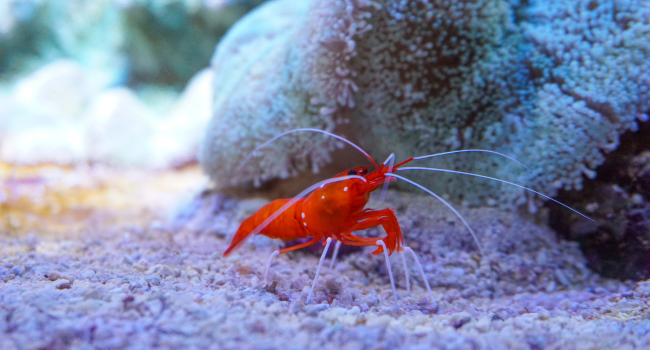
| Characteristics | Details |
| Scientific Name | Lysmata spp. |
| Habitat | Marine Environments |
| Behavior | Protogynous, Cleaner Shrimp |
| Unique Features | Symbiotic Cleaning Relationship |
8. Seabass (Moronidae)
Protogynous species are within the wide group of fish known as seabass, which can be found in both freshwater and marine habitats.
The transformation of females into males as they become older guarantees a balanced population of both male and female breeding mates.
In many aquatic environments, seabass play a vital role as a primary predator, making them both economically and ecologically significant.
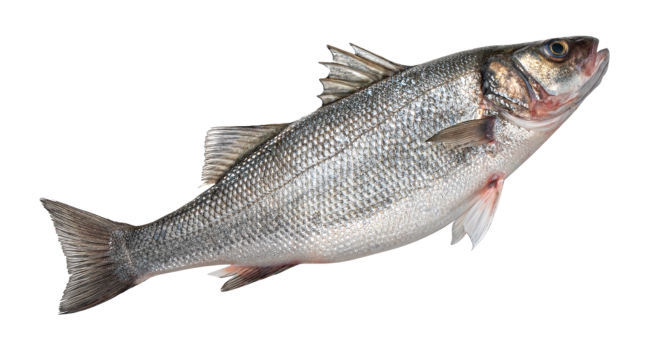
| Characteristics | Details |
| Scientific Name | Moronidae |
| Habitat | Freshwater and Marine |
| Behavior | Protogynous, Key Predators |
| Unique Features | Commercial and Ecological Value |
9. Hamlets (Hypoplectrus spp.)
A collection of tiny, vibrant fish known as hamlets can be seen in the western Atlantic Ocean.
When a dominant male is missing from a population of these fish, the largest female switches sexes and takes over as the new dominant male.
Hamlets are essential components of reef ecosystems because they help keep prey populations under control and promote biodiversity.
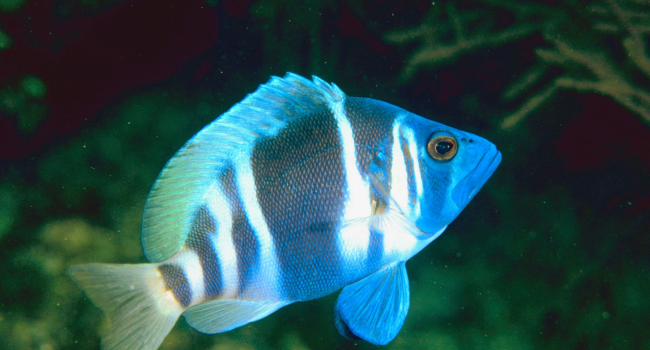
| Characteristics | Details |
| Scientific Name | Hypoplectrus spp. |
| Habitat | Western Atlantic Ocean |
| Behavior | Protogynous, Reef Dwellers |
| Unique Features | Colorful, Complex Social Structure |
10. Black Porgy (Acanthopagrus schlegelii)
The western Pacific Ocean is home to the black porgy, commonly referred to as the black seabream.
Black porgy females shift from female to male as they become older, adding to the population’s genetic diversity and propensity for reproduction.
Black porgy play an important role in the health of marine ecosystems and are essential to marine food chains.

| Characteristics | Details |
| Scientific Name | Acanthopagrus schlegelii |
| Habitat | Western Pacific Ocean |
| Behavior | Protogynous, Marine Food Chains |
| Unique Features | Importance in Ecosystems |
11. Olive Fairy Wrasse (Cirrhilabrus olivaceus)
The Western Pacific is home to the stunning and colorful olive fairy wrasse. This species, like many wrasses, is protogynous.
The largest female undergoes a sex change and takes on the function of the dominant male when the dominant male of a social group is eliminated or passes away. Olive fairy wrasses enhance the beauty and ecological harmony of reef ecosystems.
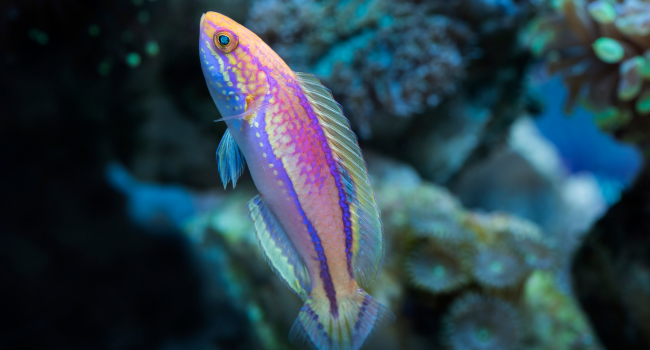
| Characteristics | Details |
| Scientific Name | Cirrhilabrus olivaceus |
| Habitat | Western Pacific |
| Behavior | Protogynous, Reef Inhabitants |
| Unique Features | Colorful, Social Behavior |
12. Peacock Blenny (Salaria pavo)
Small and vibrant peacock blennies can be found in the Mediterranean Sea and some of the Atlantic Ocean.
The largest female in a group of peacock blennies has the ability to turn into the new male and occupy the space left by the absent male. These blennies add charm to their aquatic habitats and are noted for their interesting mating practices.
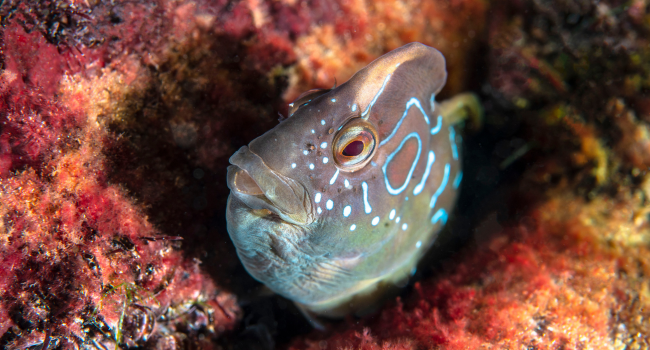
| Characteristics | Details |
| Scientific Name | Salaria pavo |
| Habitat | Mediterranean and Atlantic |
| Behavior | Protogynous, Intriguing Mating Behaviors |
| Unique Features | Colorful, Unique Mating Strategies |
13. Banggai Cardinalfish (Pterapogon kauderni)
The Banggai cardinalfish is a rare species that can only be found in the Indonesian Banggai Islands. This species demonstrates protogyny, whereby females develop into males as they get older.
The male of the Banggai cardinalfish guards and looks after the eggs until they hatch, making it known that it provides paternal care.
These alluring fish have gained popularity in the aquarium industry, highlighting the necessity of ethical conservation methods.
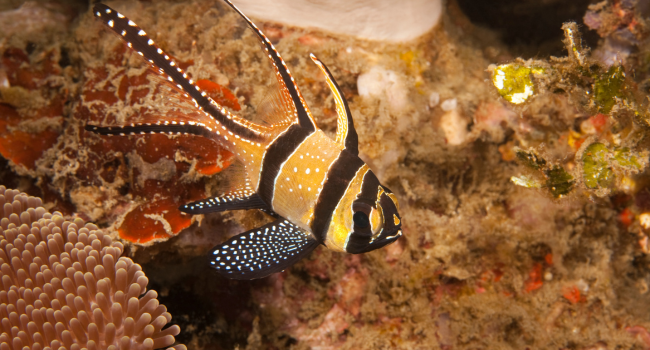
| Characteristics | Details |
| Scientific Name | Pterapogon kauderni |
| Habitat | Banggai Islands, Indonesia |
| Behavior | Protogynous, Paternal Care |
| Unique Features | Popularity in Aquarium Trade |
14. Bluehead Wrasse (Thalassoma bifasciatum)
The Western Atlantic Ocean is home to the stunning reef fish known as the bluehead wrasse. It is renowned for both its distinctive behavior and beautiful color.
The biggest and most dominant females in bluehead wrasse populations have the ability to alter their sex and turn into males, assuring the group’s reproductive success. These fish contribute to the total diversity of marine life and make coral reefs more vibrant.
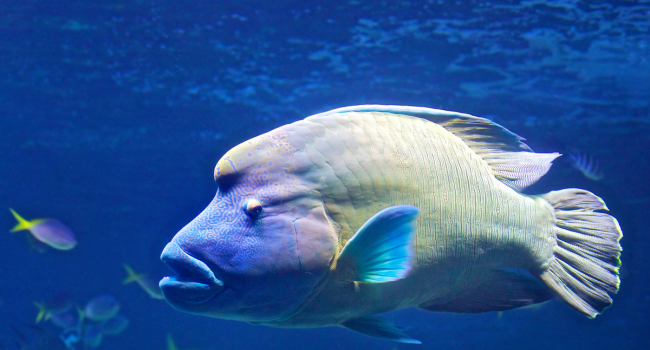
| Characteristics | Details |
| Scientific Name | Thalassoma bifasciatum |
| Habitat | Western Atlantic Ocean |
| Behavior | Protogynous, Reef Inhabitants |
| Unique Features | Striking Coloration, Social Behavior |
15. Anemonefish (Amphiprioninae)
Anemonefish also referred to as clownfish, live in harmony with sea anemones.
The anemone defends the anemonefish, while the anemonefish give the anemone nourishment in this interesting cooperation.
Because anemonefish are protogynous, when the dominant male in the group dies, the females change into males. These recognizable fish are adored for their eye-catching hues and captivating antics.
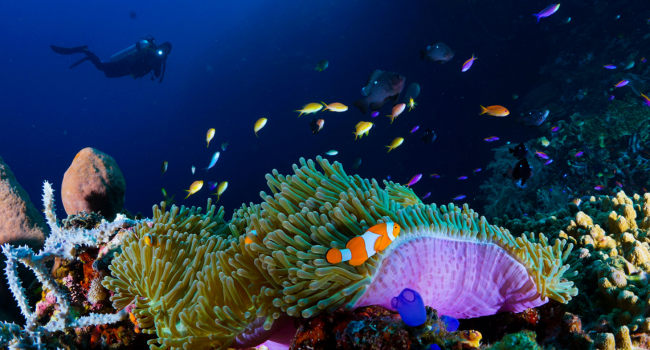
| Characteristics | Details |
| Scientific Name | Amphiprioninae |
| Habitat | Coral Reefs |
| Behavior | Protogynous, Symbiotic with Anemones |
| Unique Features | Vibrant Colors, Engaging Behaviors |
Conclusion:
The world of protogynous fish is a fascinating testament to the diverse and ingenious strategies nature employs to ensure the survival and sustainability of aquatic ecosystems. Each species plays a vital role in maintaining the delicate balance of marine life.
Protogyny highlights the adaptability and resilience of aquatic organisms. Understanding the intricacies of these sex-changing behaviors not only deepens our appreciation for the wonders of the underwater world but also underscores the importance of conservation efforts to protect these magnificent creatures.
Also Read: 22 Types of Fish That Can Change Their Gender
Environmental Factors Influencing Gender Change in Fish
Are all clownfish protogynous?
While the majority of clownfish species are protogynous, not all of them exhibit this behavior. The most famous example is the common clownfish (Amphiprion ocellaris), which famously inspired the character “Nemo” in the movie “Finding Nemo.”
How does protogyny benefit marine ecosystems?
Protogyny helps maintain a balance between male and female fish in populations, ensuring successful breeding opportunities. This balance contributes to the health and diversity of marine ecosystems by preventing skewed sex ratios and supporting population sustainability.
Are protogynous fish more vulnerable to overfishing?
Yes, some protogynous fish are more vulnerable to overfishing, especially those that take a considerable amount of time to transition from female to male. Due to their slow growth and late sexual maturity, targeted fishing practices can have a significant impact on their populations.
Do protogynous fish have specific breeding behaviors?
Protogynous fish often display complex breeding behaviors. For example, some species undergo courtship rituals or have distinct mating territories. Additionally, the change in sex can lead to changes in behavior, such as males assuming territorial defense and parental care responsibilities.
How does protogyny differ from protandry?
Protogyny refers to the process where fish change from female to male, while protandry is the opposite, where fish transition from male to female. Both phenomena are forms of sequential hermaphroditism and are observed in different fish species around the world.
